Design Doha
M7 Museum
Doha, Qatar
Through August 5
When you exit the Souq Waqif, walk past its falcon hospital, cross the market’s western plaza, and enter Doha’s new Msheireb district, you are time traveling from the early 20th century to the early 21st. The Msheireb, realized in phases at a cost of $5.5 billion, is a contemporary downtown neighborhood of over 100 buildings, most of which are faced in a pale stone and built to LEED Gold environmental standards. The district’s M7 cultural center, designed by John McAslan + Partners, sits next to a run of smaller museums and the country’s national archive. Now it hosts Design Doha, a new biennale that centers the work of designers in the MENA region, or the Middle East and North Africa.
Design Doha opens after the rapid development of arts and architecture event infrastructure in the region, with programs like the Sharjah Architecture Triennial, which held its first edition in 2019 in the United Arab Emirates, and last year’s inaugural version of the Islamic Arts Biennale, hosted in Jeddah, Saudi Arabia.
Doha’s biennale is organized by its artistic director Glenn Adamson, whose interest in modern craft explains his selection for this role. Craft is not “a separate category from art and design—more as a way of getting things done expertly within those spaces,” he told me via email after the event’s opening festivities. “I find the works that result from this intensive investment in process and materiality to have an integrity and beauty that you can’t get to any other way.”
Design Doha consists of five main exhibitions with an array of supporting events. It demonstrates Qatar’s ongoing investment in culture at a scale and speed that boggles an American mind: I. M. Pei’s Museum of Islamic Art opened in 2008, Jean Nouvel’s National Museum of Qatar completed in 2019, and other museums dedicated to contemporary art, sports, cars, and more are under construction or anticipated. Additionally, Qatar has installed of over 100 public artworks across the country, a peninsula within the Persian Gulf roughly the size of Connecticut, and maintains serious art collecting practices led by Sheikha Al-Mayassa bint Hamad bin Khalifa Al-Thani, the sister of the emir. These efforts took place in advance of Qatar’s hosting of the World Cup in 2022 but also as part of its wider transformation to meet the goals of the country’s National Vision 2030.
In the midst of all this statecraft, Design Doha offers a fresh and inspiring look at the state of design across the MENA region. The core aim was to “provide a platform for participation and professionalization among Arab designers themselves,” Adamson told me via email after the biennale’s opening festivities. Still, the work on view—and especially that of Arab Design Now, the main show curated by Rana Beiruti—is educational for global audiences, even at a distance. The exhibitions and events establish Doha as a destination for design culture.
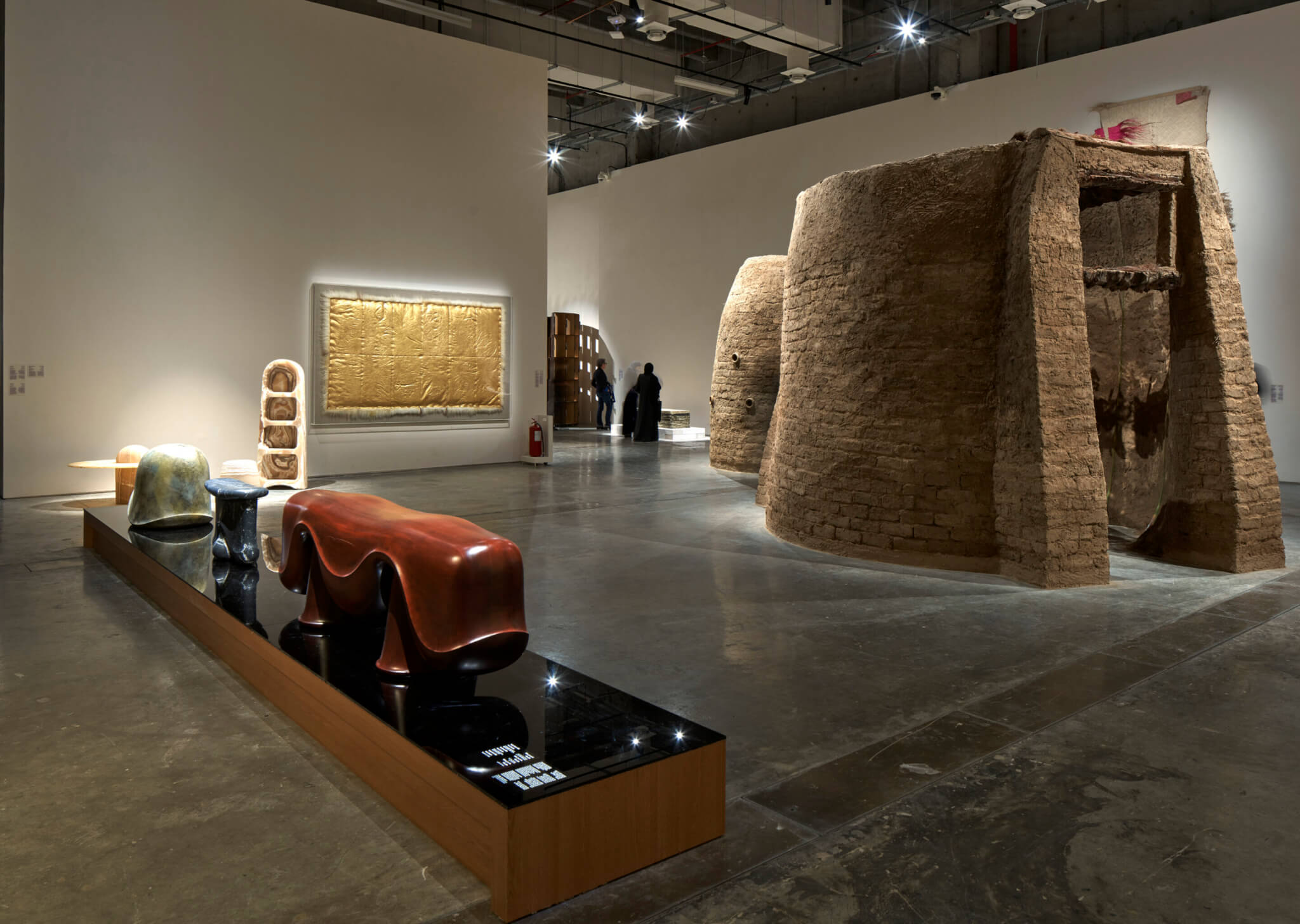
Beiruti, an Amman, Jordan–based curator and cofounder and director of Amman Design Week, began her work with a question: What does it mean to create in our region today? During Design Doha’s opening press conference, she remarked that the MENA region has incredible diversity, as seen in its geographies, personal backgrounds, histories, and cultures. “We wanted to celebrate that diversity and make sure that we share all of the stories that this rich region has to offer,” she said. But there are unifying aspects, like a concern for material processes, responses to arid desert climates, a respect for the land, and the Arabic language. Craft is perhaps the central theme for Arab Design Now. Beiruti observed, “A lot of the designers in our region have dug into this past and are trying to revive traditional practices by working closely with craftspeople across the region.”
Arab Design Now
Arab Design Now, which features 74 designers in the largest survey of Arab design to date, contains a wide spread of design mediums and explorations, from tapestries to furniture, lighting, products, and objects. Many of the pieces were commissioned for this exhibition, meaning they were made for the reason of self-expression without demands of a client.
Beiruti’s curation of Arab Design Now unfolds over two floors of the M7, and her ambitions are clear from the first piece encountered in the lobby: Lovers Bench, by the Lebanese artist and designer Najla El Zein. The piece consists of two hand-carved pieces of Ceppo stone together. One bends to rest atop other; their floppy character is heightened by the reality of the stone, which is flecked with large chunks of marble. They look like nougats melted under windshield heat—or, two lovers in repose. The bench introduces viewers to a show that’s formally inventive, material-focused, and charged with meaning.
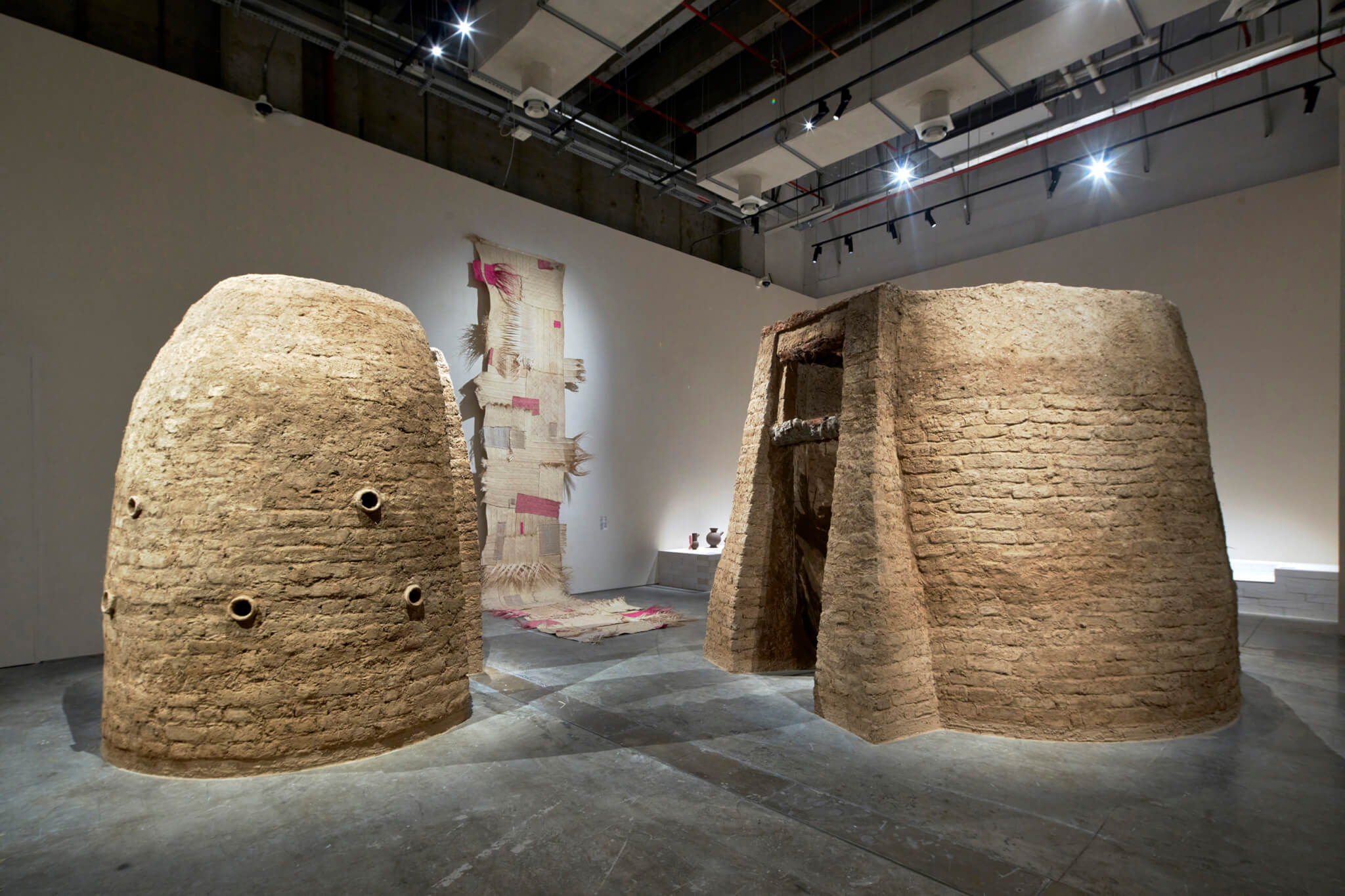
Earth-centric
A consistent theme is the use of the environment as both a source of inspiration and a resource for making. In one gallery, the Morocco-based architect Salima Naji has built two pavilions from raw earth, bamboo, and palm trees using traditional techniques. Her piece, Sharing the Earth (Spatial Interiorities), creates two cocoons while including typical devices like skylights and apertures for ventilation. Upstairs, a grove of 11 terra-cotta columns are the work of Jordanian architect Sahel Alhiyari. Each is composed of individual pieces cast using a custom extrusion mold that creates a radial, churro-like profile. Alhiyari described the process of turning the molds, which introduces torsion and makes each piece a bit curvy. These pieces are hollow and could be filled with rebar and concrete for additional strength if used for construction.
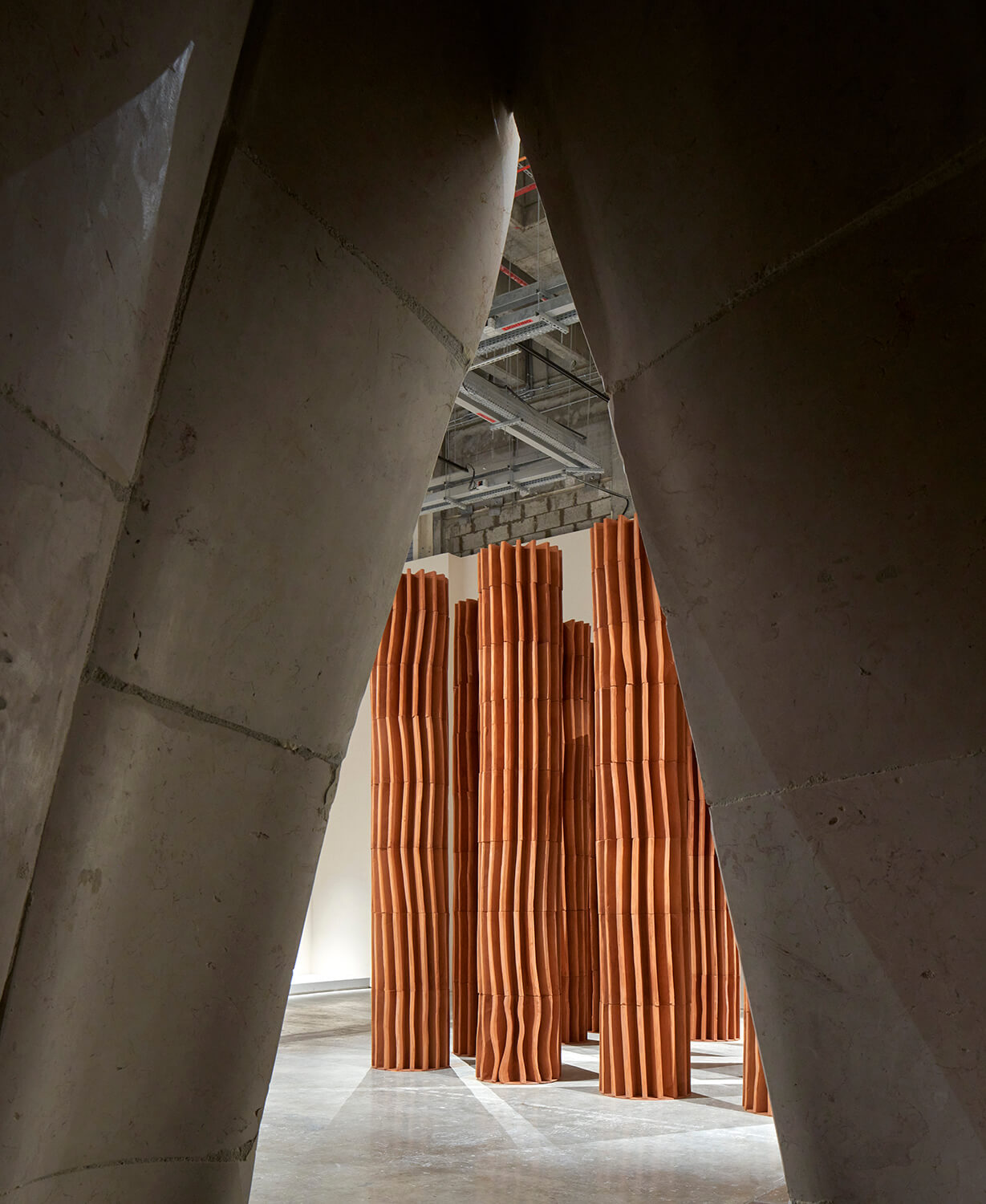
Downstairs, Sediments by the Syrian-born, UAE-based creative Talin Hazbar consists of recovered fishing rope cast into slabs, a comment on the polluted state of our oceans that uses “ghost gear” as its material. (The ropes seen here were fished from the Persian Gulf by the Dubai voluntary diving team.) In the first room, Sites – New Sites by the Bahrain-based, Dutch architect Anne Holtrop suspends resin casts of the surfaces of Qatari land on a mobile steel armature. Visitors are encouraged to push the pieces around, which in turn changes the space of the gallery.

Mockup Testing
Other designers used the opportunity to realize bits of larger projects. New South, a Paris-based office led by Meriem Chabani and John Edom, presented Kursi, a set of ceramic stools that can be moved around and sat on. Chabani said the offering is connected to the practice’s ongoing design of a mosque; the abstracted grid on the floor and the reconfigurability suggests various ways of creating sanctuary.
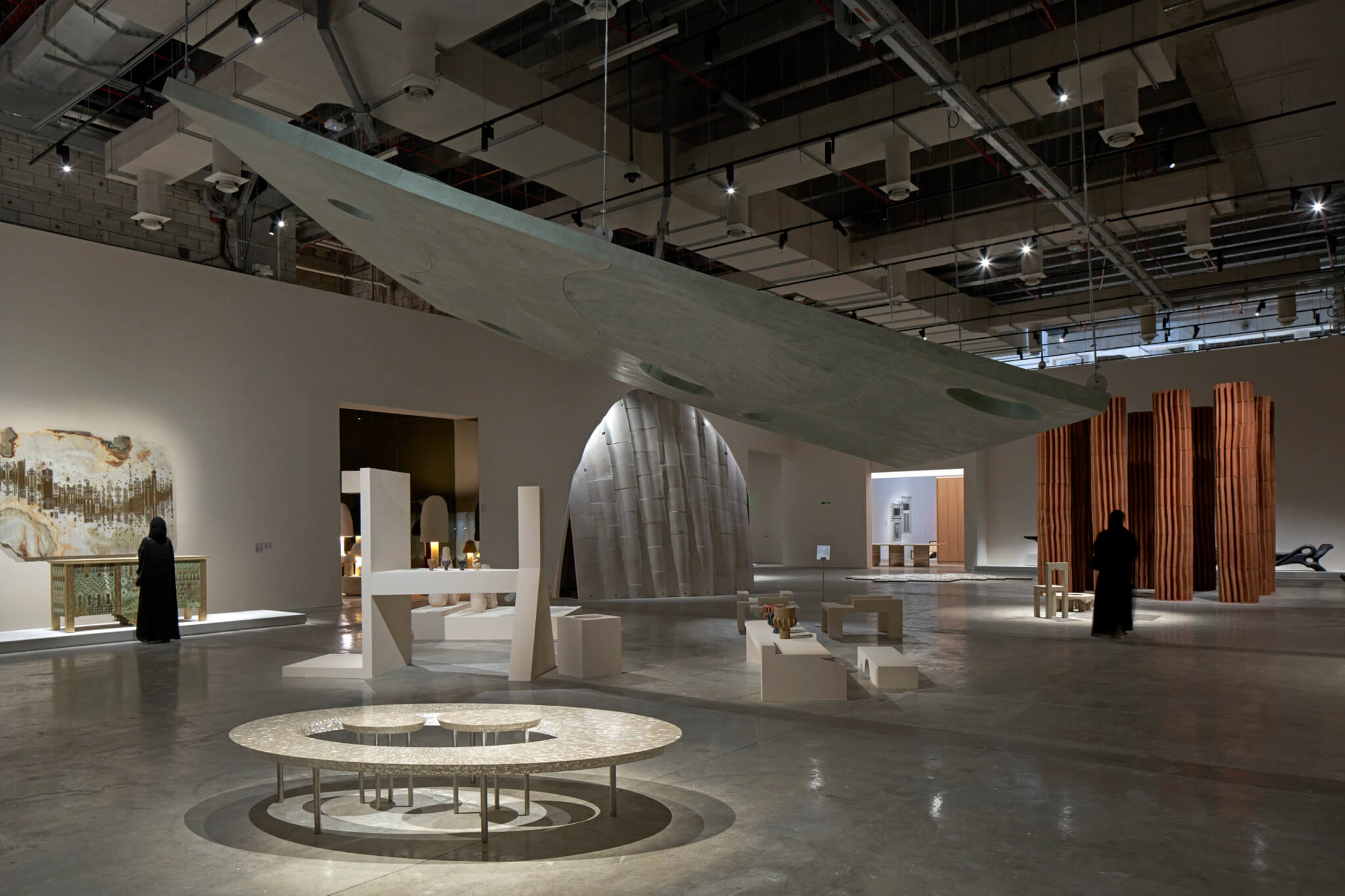
Hovering above furniture in a large gallery is House Between a Jujube Tree and a Palm Tree, a 1:1 fiberglass version of the roof of a home designed by Civil Architecture and suspended from steel cables. It was meant to cover a garden majlis (outdoor room) in Manama, Bahrain. The impressive surface is punctured by holes to accommodate the trunks of these common trees, and the roof’s gently undulating form “correspond[s] to depressions that were meant to collects fruit from two trees that bear fruit during separate times of the year,” Hamed Bukhamseen, one of Civil Architecture’s cofounders, told me. (The other cofounder, Ali Ismail Karimi, has contributed to AN.)
Nearby, Tiamat by AAU ANASTAS, led by brothers Elias and Yousef Anastas, is the latest product of the Palestine- and Paris-based practice’s research on stone. (In addition to running their practice and teaching summer studios at Columbia GSAPP, the Anastases also operate Radio Alhara, a popular Palestinian online radio station they created in March 2020.) Inspired by both natural rock formations and the pointed arches of Gothic architecture, this inhabitable shell combines historic stone construction techniques with digital technology and fabrication to broadcast the structural abilities for a material that today is often relegated to cladding or countertops. Consisting of thickened stone ribs that rise to a curved ridge, the “organism” is built in stacked pieces of Niassa limestone. Much like a cathedral or ribcage, the interior is dark and reverberant.
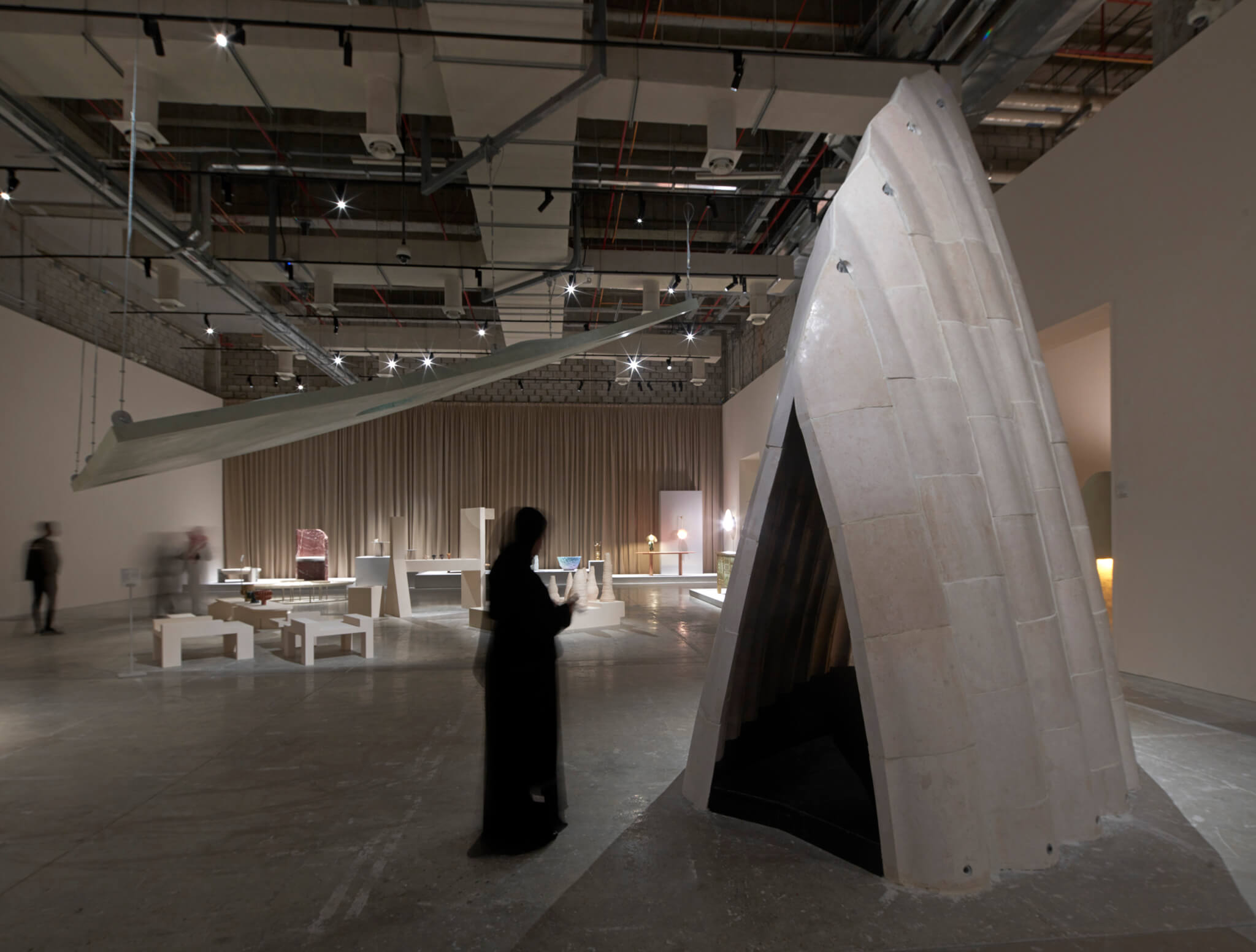
Glassy Histories of Exchange
Several pieces evidence the traffic of craft histories between the Middle East and its neighbors via glass. In a small room, one encounters a feat of Murano glass: Constellations 2.0: Object. Light. Consciousness., by Jordanian architect Abeer Seikaly. The torus consists of over 5,000 pieces of glass, tightly woven together in a way that links Venetian glassmaking with Bedouin weaving. With the lighting element concealed within the form, it cast a textile-like throw of shadows. The experience was powerful enough to land Seikaly with the 2024 Design Doha Prize in the Craft category.

Upon exiting the elevator—which is filled by Whispers from the Deep, by T SAKHI: Tessa & Tara Sakhi, a menagerie of imaginary sea creatures also blown in Murano glass—one sees a tall column of cast glass pieces set on a steel structure. It, An Archive for Modern Glass, is the work of Jeddah, Saudi Arabia–based BRICKLAB, with production by 6:AM, a brand that is reinventing Venetian glass. The glass pieces are based on source pieces found in modernist structures realized in the second half of the 20th century thanks to oil profits in Jeddah. Here, they are reimagined as a repository of artifacts from an era that is old enough to warrant conversations about its preservation.
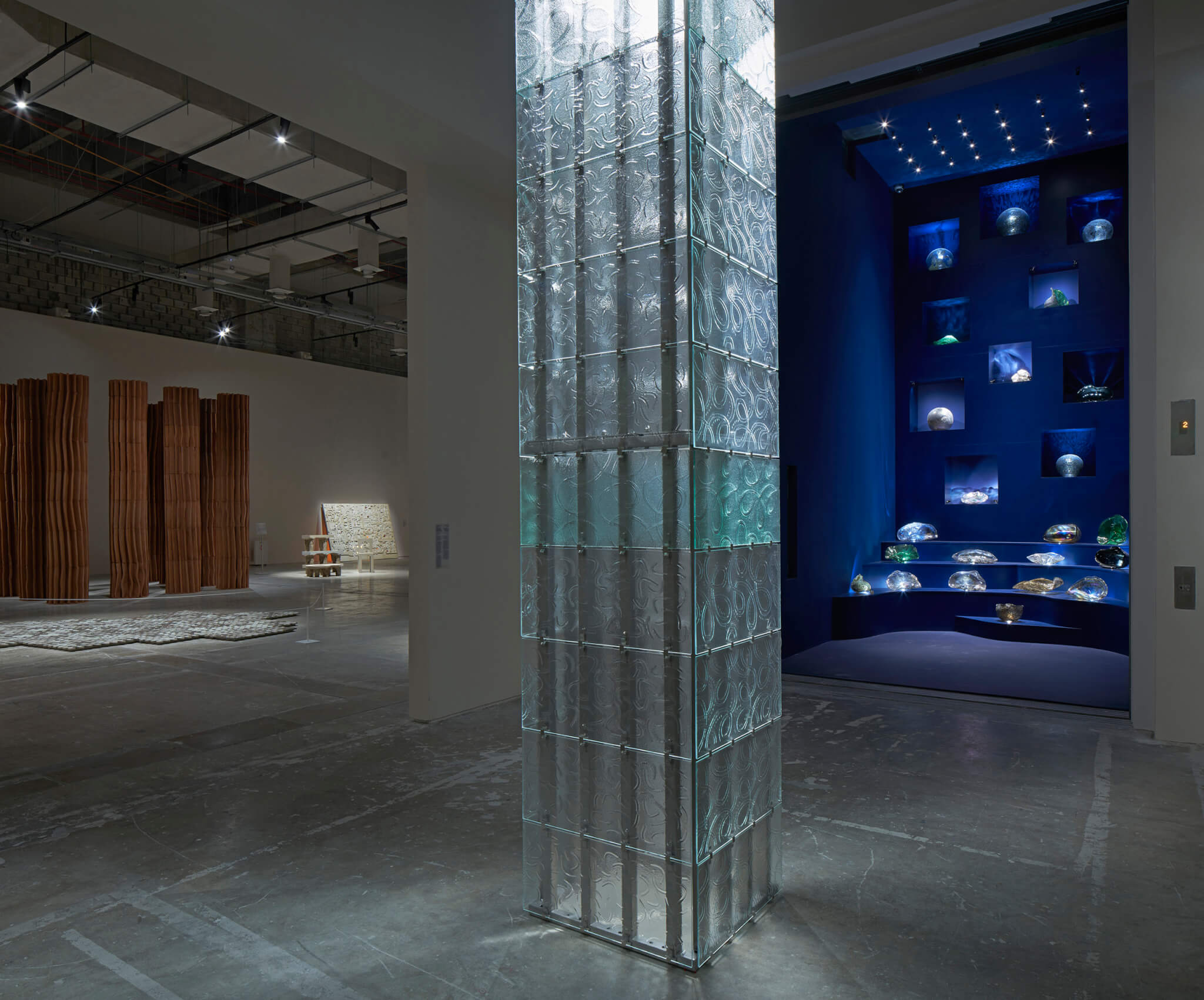
Transparent Histories, a room divider by Palestinian architect Dima Srouji (who was recently featured in AN Interior), speculates on the archeology of a future Jerusalem from below. In a manner reminiscent of Piranesi’s Campo Marzio drawings of Rome, the piece, realized in Jerusalem limestone with backlit glass portions, collapses together plans of existing and imagined portions of the city. Srouji, who for the last decade has worked in glass in collaboration with glassmakers in Bethlehem, told me that during the process of making the piece she learned that her great-great-grandfather was a stonemason, so the research was in part an excavation of family history. Srouji’s grandfather was also an architect; he lost his practice in the war in 1967, but she was able to incorporate some of his drawings into the divider’s palimpsest layering. Some of those houses don’t exist anymore, she said.
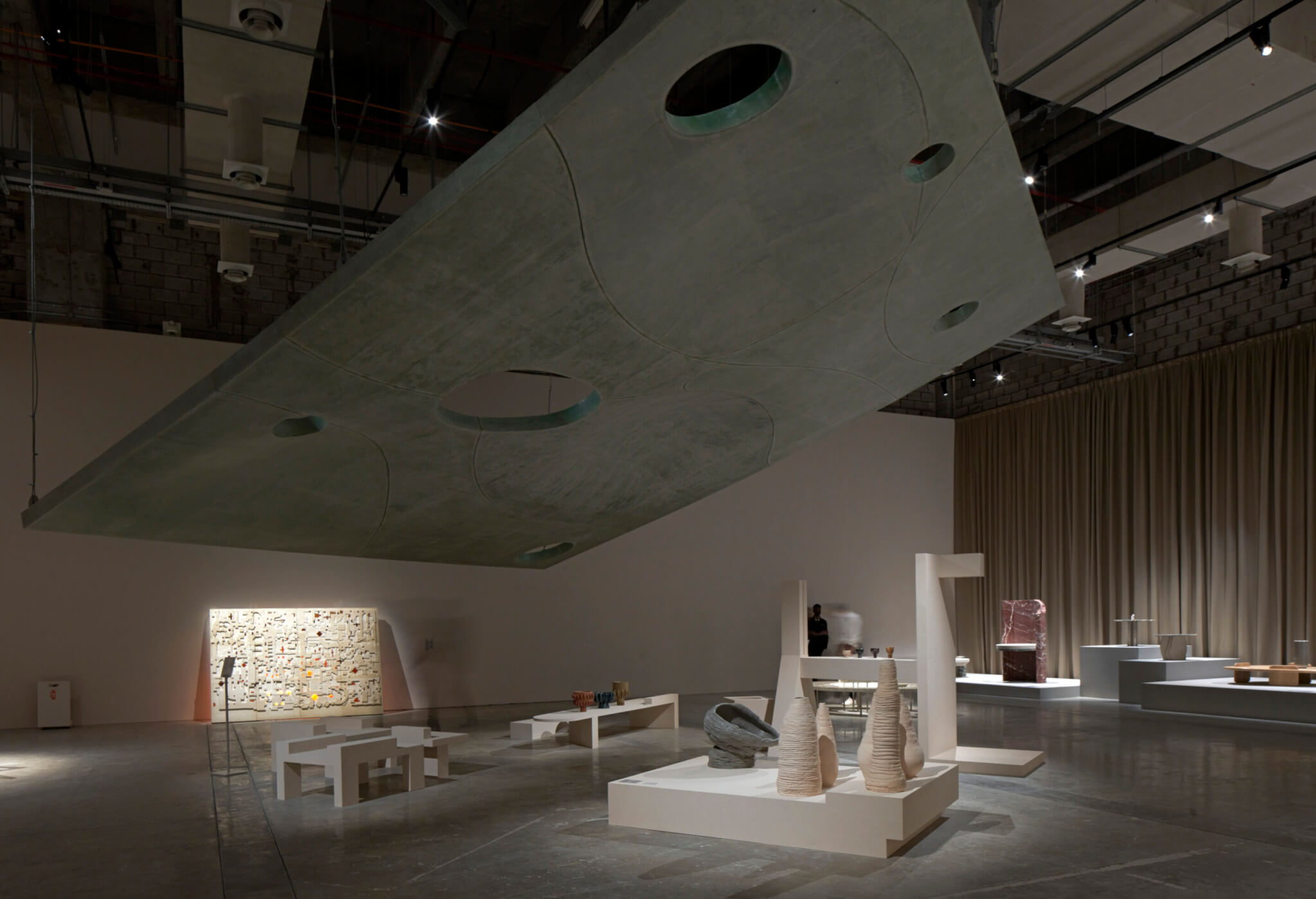
Machined Options
Lest it all seem too earthy, there were examples of industrial and digital fabrication on view. Light Impact, by the Lebanese atelier Fabraca Studios, consists of a chain of aluminum links with adjustable lighting elements. The piece was commissioned to replace a shattered glass chandelier destroyed in the aftermath of the 2020 Beirut explosion. Its futuristic look was rewarded with a 2024 Design Doha Prize in the Product Design category. In a later room, the Constellation C080 table by david/nicholas is installed within B02, a French-oak modular shelving system that sets heavy oak shelves on a concealed metal frame; each height is indicated by a triangle carved into the backing panel, reminiscent of the elevation datums of architectural drawings.

Still many more objects and stories are on view in Arab Design Now, which brims with excellent work. The showing evidences the broad spectrum of design work from the region, which should be understood as operating in dialogue with the rest of the world: Many of the designers live and work, or were educated and/or teach, beyond the geographic limits of the Middle East.
Additional Showings
Besides Arab Design Now, four other exhibitions comprise Design Doha’s main offerings. In the M7’s unfinished theater space, Weaving Poems displays carpets designed by Afghan-born, Amman-based artist and designer Maryam Omar, who worked with women weavers in Afghanistan. Omar began by listening to the stories of this community and making watercolors; these were then translated into weaving software to create 1:1 graphs that were printed in Afghanistan and used as roadmaps for the weaving process. In addition to the carpets themselves, the darkened shell is animated by photography of the work and the surrounding landscape. The show, organized by Turquoise Mountain, a British nonprofit that supports artisans and craft heritage, is the “emotional heart of the biennale,” Adamson said onsite.

Crafting Uzbekistan: Tradition in Threads showcases the country’s historic and contemporary craft through the display of 50 objects, including silk ikat and Bakhmal fabrics and hand-carved wood screens and bookholders. The exhibition was designed by the Bahraini practice Shepherd Studio and includes mirrored socles set on an “optical carpet” of lenticular plastic tiles. The standout piece was a new tapchan, an elevated, enclosed, outdoor bench for socializing common to the region, designed by Lebanese designer Nada Debs and built by Uzbek master woodworker Sirojiddin Rahmatillaev.

Another exhibition, Colours of the City, captured the phases of Doha’s architecture during the 20th century as the city endured rapid growth and development. According to historian and co-curator Peter Tamas Nagy, the show is in part a rallying cry for modern preservation: Most of the buildings documented in its early chapters are either endangered, or already gone. Great (and little-known) works of art deco and Brutalist architecture are understood through photography and drawings. In the last portion of the show, a set of models documents the career of Qatar’s most prominent architect, Ibrahim Al Jaidah. (Al Jaidah, who was educated at the University of Oklahoma, published with Rizzoli a guide to Arabian Deco last year.) The final model is of Al Jaidah’s most prominent commission: Al Thumama Stadium, built for the World Cup in 2022.
Scaling Up
Design Doha took place during heightened regional instability. While I was there, Qatari diplomats were working to negotiate a ceasefire in Gaza, a process that remains ongoing, with Qatar playing a key role. The country’s leadership has a clear position: On the opening night of Design Doha, a message of support for Palestine was projected onto M7’s stone facade, followed by the Palestinian flag. The biennale and the 2022 World Cup perhaps arrive in a moment of relative Gulf unity, after a diplomatic crisis in 2017 isolated Qatar from its neighbors; normal relations resumed in 2021. Adamson shared that the biennale has had a positive response beyond what was anticipated. “Especially at such a tough time in the region, it was very meaningful for people to come together around a shared experience of creativity,” he said.
Just over a week after he spoke at Design Doha, the British architecture critic Edwin Heathcote published a text in Dezeen about the “impossibility of architecture criticism” when faced with the devastation in Gaza. What is the appropriate critical response to urbicide? “Gaza will be rebuilt, but how will we rebuild our discourse if we continue to ignore the destruction and see it only as news and not as culture?”
How does one responsibly speak about design during a time of conflict? Beyond the demand for an “immediate ceasefire” in Gaza and the cessation of the war machine more generally (including the American one), perhaps one useful response is a renewed interest in supporting the experiences, cultures, histories, and designs of people in the Middle East in an effort to distribute understanding such that it sows peace. In that sense, Design Doha is an instrument that communicates simultaneous unity and diversity among Arab designers, and its existence is a testament to the region’s cultural vibrancy.

The things designers make embody their makers’ values, histories, and ideas. Part of the capacity of objects is their ability to store and share memory, which is then transmitted to its users and viewers. To pay attention to these stories spreads awareness of a range of cultures, an act of listening that is especially important when whole histories are under threat.
In the biennale I saw Lahmu, made by Sizar Alexis: a blackened oak console with curved tops that are inspired by the Iraqi bunkers in which Alexis and his family sheltered when the U.S. invaded. Upstairs in a small side room, Mohammad Sharaf installed After the End, a wall made of brick-sized copies of a photobook that documented 50 years of abandoned places in Kuwait, capturing places that have disappeared. At Liwan Design Studios and Labs, a girls’ school converted in space for design residencies, I saw the work of Palestinian designer Majdulin Nasrallah. She shared 1948, a project for which she cast candles that transmit scents from the Palestinian landscape. The box set contains a concrete base, but the limited edition has a candleholder cast in aluminum collected from tear-gas canisters that have been remelted. The materials were smuggled through Israeli checkpoints, and so the pieces, as she writes on her website, “embody the reality of life under occupation.”
In a panel discussion, Beiruti observed that one takeaway is a feeling of optimism among the network of Arab designers whose work appears here. There has been progress: Previously, she said the word hope was used to describe the scene. Now, in Doha, the word is power. After a strong inaugural showing, the biennale has its work cut out when it returns in 2026.

